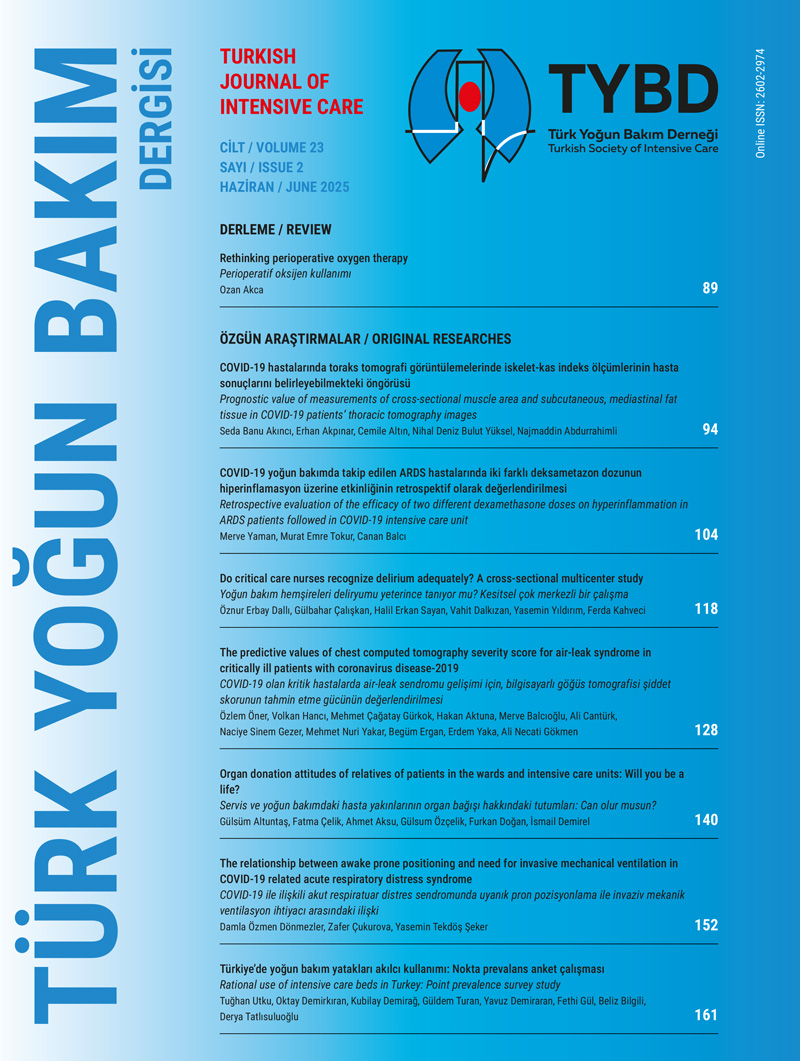Öz
Oksijen kullanımı perioperatif dönemin önemli öğelerinden birisidir. Ancak, son yıllarda yüksek inspiratuar oksijen konsantrasyonlarının rutin kullanımı sorgulanmaktadır. Perioperatif dönemde hem hipoksi hem de hiperoksi önemli riskler taşır — bunlar arasında inflamasyon, oksidatif stres, vazokonstriksiyon ve organ perfüzyonunun bozulması yer alır. Bu organ hasarları, özellikle kardiyak -torasik cerrahilerde ve yüksek riskli hastalarda daha belirgin olarak gözlenmiştir.
Noninvaziv hemodinamik ve oksijenizasyon monitörizasyonunda son gelişmeler oksijen sunumunun (DO2) dinamik ve bireyselleştirilmiş şekilde ayarlanmasına olanak tanımakta, ve geleneksel SpO2 hedeflerinin ötesine geçmektedir. O nedenle perioperatif kardiyak ve serebrovasküler girişimlerde hedeflenmiş oksijen sunumu yaklaşımı giderek önem kazanmaktadır. Oksijenin, dozu ayarlanan bir ilaç olarak görülmesi, intraoperatif ve perioperatif bakımda fizyolojik temellere dayanan bir yaklaşımla uygulanması hastalarımızın cerrahi sonuçlarının iyileşmesine daha faydalı olabilir.
Anahtar Kelimeler: oksijen, oksijen sunumu, hipoksi, hipoksemi, hiperoksi, cerrahi, hemoglobin, kardiyak output, basıncı, akut bobrek hasarı, organ hasarı
Referanslar
- Yellon DM, Hausenloy DJ. Myocardial reperfusion injury. N Engl J Med. 2007;357:1121-35. https://doi.org/10.1056/NEJMra071667
- McIlroy DR, Shotwell MS, Lopez MG, et al. Oxygen administration during surgery and postoperative organ injury: observational cohort study. BMJ. 2022;379:e070941. https://doi.org/10.1136/bmj-2022-070941
- Koksal GM, Dikmen Y, Erbabacan E, et al. Hyperoxic oxidative stress during abdominal surgery: a randomized trial. J Anesth. 2016;30:610-9. https://doi.org/10.1007/s00540-016-2164-7
- Liang Y, Ruan W, Jiang Y, Smalling R, Yuan X, Eltzschig HK. Interplay of hypoxia-inducible factors and oxygen therapy in cardiovascular medicine. Nat Rev Cardiol. 2023;20:723-37. https://doi.org/10.1038/s41569-023-00886-y
- Greif R, Akça O, Horn EP, Kurz A, Sessler DI, Outcomes Research Group. Supplemental perioperative oxygen to reduce the incidence of surgical-wound infection. N Engl J Med. 2000;342:161-7. https://doi.org/10.1056/NEJM200001203420303
- Kuh JH, Jung WS, Lim L, et al. The effect of high perioperative inspiratory oxygen fraction for abdominal surgery on surgical site infection: a systematic review and meta-analysis. Sci Rep. 2023;13:15599. https://doi.org/10.1038/s41598-023-41300-4
- Akça O, Melischek M, Scheck T, et al. Postoperative pain and subcutaneous oxygen tension. Lancet. 1999;354:41-2. https://doi.org/10.1016/S0140-6736(99)00874-0
- Akca O, Ball L, Belda FJ, et al. WHO Needs High FIO2? Turk J Anaesthesiol Reanim. 2017;45:181-92. https://doi.org/10.5152/TJAR.2017.250701
- Allegranzi B, Zayed B, Bischoff P, et al. New WHO recommendations on intraoperative and postoperative measures for surgical site infection prevention: an evidence-based global perspective. Lancet Infect Dis. 2016;16:e288-303. https://doi.org/10.1016/S1473-3099(16)30402-9
- Berríos-Torres SI, Umscheid CA, Bratzler DW, et al. Centers for Disease Control and Prevention Guideline for the Prevention of Surgical Site Infection, 2017. JAMA Surg. 2017;152:784-91. https://doi.org/10.1001/jamasurg.2017.0904
- Magruder JT, Weiss SJ, DeAngelis KG, et al. Correlating oxygen delivery on cardiopulmonary bypass with Society of Thoracic Surgeons outcomes following cardiac surgery. J Thorac Cardiovasc Surg. 2022;164:997-1007. https://doi.org/10.1016/j.jtcvs.2020.12.008
- Brown JR, Baker RA, Shore-Lesserson L, et al. The Society of Thoracic Surgeons/Society of Cardiovascular Anesthesiologists/American Society for Extracorporeal Technology Clinical Practice Guidelines for the Prevention of Adult Cardiac Surgery-Associated Acute Kidney Injury. Anesth Analg. 2023;136:176-84. https://doi.org/10.1213/ANE.0000000000006286
- Saugel B, Cecconi M, Hajjar LA. Noninvasive Cardiac Output Monitoring in Cardiothoracic Surgery Patients: Available Methods and Future Directions. J Cardiothorac Vasc Anesth. 2019;33:1742-52. https://doi.org/10.1053/j.jvca.2018.06.012
- Berkow L, Rotolo S, Mirski E. Continuous noninvasive hemoglobin monitoring during complex spine surgery. Anesth Analg. 2011;113:1396-402. https://doi.org/10.1213/ANE.0b013e318230b425
- Monk TG, Bronsert MR, Henderson WG, et al. Association between Intraoperative Hypotension and Hypertension and 30-day Postoperative Mortality in Noncardiac Surgery. Anesthesiology. 2015;123:307-19. https://doi.org/10.1097/ALN.0000000000000756
- Salmasi V, Maheshwari K, Yang D, et al. Relationship between Intraoperative Hypotension, Defined by Either Reduction from Baseline or Absolute Thresholds, and Acute Kidney and Myocardial Injury after Noncardiac Surgery: A Retrospective Cohort Analysis. Anesthesiology. 2017;126:47-65. https://doi.org/10.1097/ALN.0000000000001432
- Ackland GL, Iqbal S, Paredes LG, et al. Individualised oxygen delivery targeted haemodynamic therapy in high-risk surgical patients: a multicentre, randomised, double-blind, controlled, mechanistic trial. Lancet Respir Med. 2015;3:33-41. https://doi.org/10.1016/S2213-2600(14)70205-X
- O'Connor RE, Al Ali AS, Brady WJ, et al. Part 9: Acute Coronary Syndromes: 2015 American Heart Association Guidelines Update for Cardiopulmonary Resuscitation and Emergency Cardiovascular Care. Circulation. 2015;132:S483-500. https://doi.org/10.1161/CIR.0000000000000263
- Ibanez B, James S, Agewall S, et al. 2017 ESC Guidelines for the management of acute myocardial infarction in patients presenting with ST-segment elevation: The Task Force for the management of acute myocardial infarction in patients presenting with ST-segment elevation of the European Society of Cardiology (ESC). Eur Heart J. 2018;39:119-77. https://doi.org/10.1093/eurheartj/ehx393
- Callaway CW, Donnino MW, Fink EL, et al. Part 8: Post-Cardiac Arrest Care: 2015 American Heart Association Guidelines Update for Cardiopulmonary Resuscitation and Emergency Cardiovascular Care. Circulation. 2015;132(18 Suppl 2):S465-82. https://doi.org/10.1161/CIR.0000000000000262
- Rodgers ML, Fox E, Abdelhak T, et al. Care of the Patient With Acute Ischemic Stroke (Endovascular/Intensive Care Unit-Postinterventional Therapy): Update to 2009 Comprehensive Nursing Care Scientific Statement: A Scientific Statement From the American Heart Association. Stroke. 2021;52:e198-210. https://doi.org/10.1161/STR.0000000000000358
- Martin D, Grocott M, Bellomo R. Oxygenation targets in acutely ill patients: still a matter of debate. Lancet. 2018;392:2436. https://doi.org/10.1016/S0140-6736(18)32219-0
- Chu DK, Kim LH, Young PJ, et al. Mortality and morbidity in acutely ill adults treated with liberal versus conservative oxygen therapy (IOTA): a systematic review and meta-analysis. Lancet. 2018;391:1693-705. https://doi.org/10.1016/S0140-6736(18)30479-3
- Akca O. Hyperoxia: is it a biomarker for mortality? Intensive Care Med. 2015;41:1873-4. https://doi.org/10.1007/s00134-015-3975-y
- Goeddel L, Akça O. Perioperative acute kidney injury. Turk J Intensive Care. 2023;21:153-61. https://doi.org/10.4274/tybd.galenos.2023.23855
- Conrad C, Eltzschig HK. Disease Mechanisms of Perioperative Organ Injury. Anesth Analg. 2020;131:1730-50. https://doi.org/10.1213/ANE.0000000000005191
Telif hakkı ve lisans
Telif hakkı © 2025 Yazar(lar). Açık erişimli bu makale, orijinal çalışmaya uygun şekilde atıfta bulunulması koşuluyla, herhangi bir ortamda veya formatta sınırsız kullanım, dağıtım ve çoğaltmaya izin veren Creative Commons Attribution License (CC BY) altında dağıtılmıştır.






















